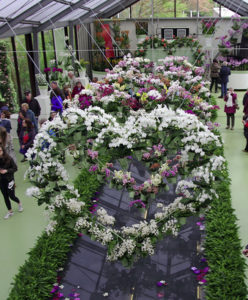Keukenhof are the showcase gardens of the Dutch bulb growing industry and are only open for eight weeks every year. They are a major tourist attraction with around 800,000 visitors a year.
The gardens are set in the grounds of a C15th hunting lodge and originally provided herbs for the kitchen. They were redesigned in the late C19th in the English parkland style, with ponds, canals, fountains and trees, which still form the basic framework.
In 1949, a group of 20 bulb exporters came up with a plan for a permanent display garden. It was an instant success and now over 100 companies exhibit their bulbs every year with over 500 flower growers providing cut flowers and pot plants.
Plantings are redesigned each year with a different theme. Approximately seven million flower bulbs are supplied free by growers and planted annually in the park. There are over 800 varieties of tulip flowering over several weeks and each bed is labelled with the variety and the grower’s name. At the end of the flowering season, the bulbs are dug up and destroyed, with most being used as food for livestock.
Plantings are carefully planned to ensure a continuous display while the gardens are open. As well as tulips, there are crocuses, daffodils, narcissi, hyacinths, crown imperials… Some beds are planted with two or three different varieties, so that when the early blooms start to fade, they are replaced by a fresh display. There is always plenty to see and the gardens really are a riot of colour. This is a wonderful place to wander. As well as the formal planted beds, there is a lake with bulbs tumbling down the banks to the water, and reflected in it. There is a small rock garden and a wild area with bulbs planted among the trees. The gardens are huge and once away from the main entrance it i possible to lose the worst of the crowds.
The windmill dates from 1892 and was originally used to pump water out of the polders. It was moved to Keukenhof in 1957. The grinding mechanism has been removed and stairs lead to a viewing area with good views of Keukenhof Gardens and neighbouring bulb fields. The boat trips leave from here.
As well as the flower gardens, there are four different pavilions in the gardens. The Juliana pavilion had an exhibition covering the story of the tulip and its cultivation. The Willem-Alexander pavilion had displays of tulips grown either in pots or in beds.
In 2017, the Oranje Nassau Pavilion contained displays of roses, which came in every colour imaginable, including red white and blue. Unfortunately very few had any scent. The painted cow was popular for selfie pictures. There were also flower arranging demonstrations.
The Beatrix pavilion is at the far end of the gardens and contained a wonderful display of orchids and anthuriums which were best seen from the observation staircase.
There is a very good shop by the entrance as well as smaller shops around he site. There are cafes and food stalls around the grounds. There are also plenty of seats.
Don’t miss the “boat trips”:http://wasleys.org.uk/eleanor/otherholidays/holland/day_two/keukenhof_three/index.html from the windmill to get a completely different view of the gardens.
Allow plenty of time for a visit as there is so much to see. Plan to arrive early. Even though we arrived shortly after opening time, there were still quite long queues to get into the gardens.
There are more pictures “here.”:http://wasleys.org.uk/eleanor/otherholidays/holland/day_two/index.html










